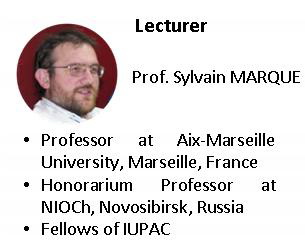
Program
Section 1: Fundamental radical chemistry
- L1: historical, stabilization vs stability (thermodynamic vs kinetics), nucleophilic,
electrophilic and ambiphilic radicals,
- L2: energetic: Pauling’s relationship and its variants, Bell-Evans-Polanyi-Semenov
relationships
- L3 + L4: Main reactions: H-transfer, addition, substitution, coupling, fragmentation,
Karash and Barton-Mccombie reactions
Section 2: basic in kinetics needed for radical polymerization
- L5: fundamentals in kinetics: first order, second order, competitive and successive
reactions, Ostwald principle, equilibrium
- L6: Arrhénius and Eyring relationships, and their limits. Curtin Hammett principle,
Hammond postulate and TS, energetics
- L7: LFER, Hammett constants, steric constants, few examples of applications.
Section 3: the link between fundamental radical reactions and radical polymerization
- L8: from radical addition to conventional radical polymerization
- L9: from Persistent radical Effect to Nitroxide Mediated Polymerization and Atom
Transfer Radical Polymerization (ATRP)
- L10 + L11 + L12: Nitroxide Mediated Polymerization and its variants
- L13 + L14: from Karash reaction to ATRP and its variants
- L15 + L16: from Barton-McCombie reaction to Reversible-Addition radical
Fragmentation Transfer polymerization
Section 4: Some examples of Applications of radical chemistry in Materials Sciences.
- L17: some applications of NMP, ATRP, and RAFT in Material Sciences
- L18: degradation of multi-layer films using a combination of techniques (EPR, IR,
ATRF, Raman, titration, Principal component Analysis, XPS).
Test
Предварительное расписание
с 5 по 12 декабря
(ежедневно, кроме сб, вс)
12.00-13.30, 14.30-17.30
Контакты
Д.А. Морозов, КОрХ НГУ, +7 913 928 43 35
Р.А. Бредихин, НИОХ СО РАН, +7 913 925 96 92


